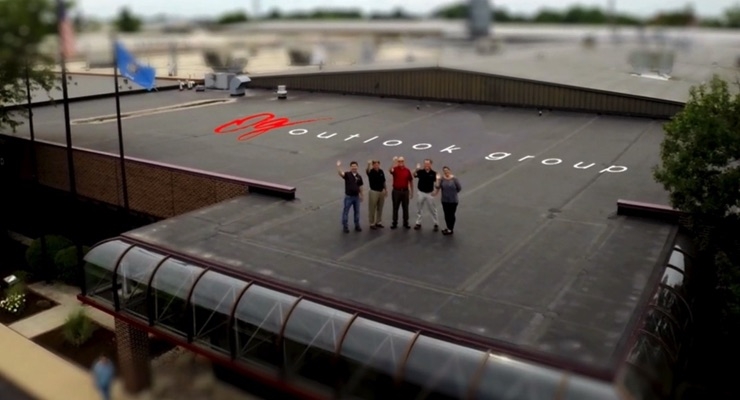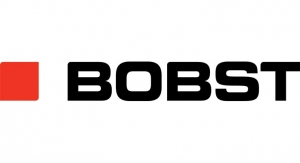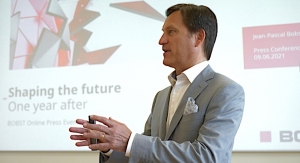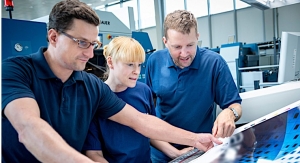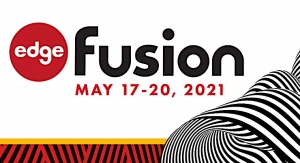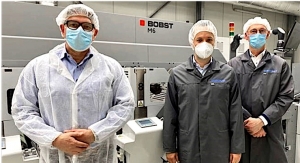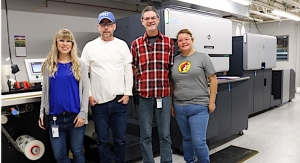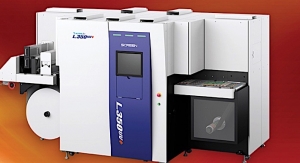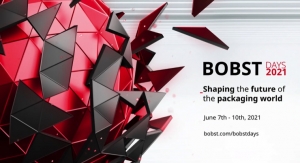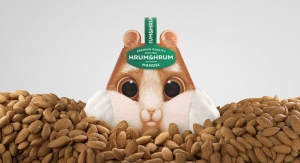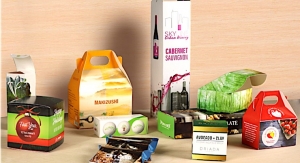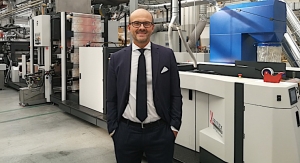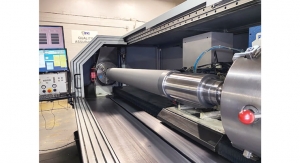Greg Hrinya, Associate Editor11.21.17
As label converters explore new ways to enhance their businesses, viable alternatives exist in the form of folding cartons and flexible packaging. While flexible packaging growth is skyrocketing, there are also benefits for converters in entering the folding carton market.
Outlook Group, a full-service converter based in Neenah, WI, USA, views folding carton production as a natural progression or growth strategy. According to Joel Schmidt, director of market development at Outlook Group, label converters already have a fundamental understanding of matching materials to an application, how to print successfully and consistently, and offer technical support assuring labels will run on application equipment. He says the same needs exist in folding cartons even though the competencies are different.
When running a folding carton application, printers will break down an art design into an elemental color make-up. As a sheet of material passes through each color station on a press, a specific color scheme is laid onto the sheet, helping build to the final image.
“This process has remained intact for numerous years,” says Schmidt. “Advancements in this arena include the ability to produce printed sheets faster–more accurately–and enabling operators to change over from one job to the next in a matter of a few minutes.”
Schmidt adds that folding carton production is segmented into three steps: Printing, Diecutting, and Gluing/Folding. Outlook Group finds that prominent producers of folding carton equipment include Komori, KBA, Kluge, Bobst, and Heidelberg. Popular materials for folding cartons–especially for Outlook Group–include SBS (Solid Bleached Sulfate, a white high gloss paperboard made from 80% virgin pulp); CCNB (Clay Coated News Back, which is made from recycled materials and offers a cost-effective price point); SUS (Solid Unbleached Sulfate, which is similar to SBS but includes a clay coated surface to enhance printability); and CNK (Clay Natural Kraft, which is similar to SUS).
Folding cartons are often utilized in the retail space. As e-commerce continues to emerge as an industry trend, folding cartons could rise in prevalence. “Folding Cartons play a key role in delivering a positive end-user experience when receiving their order,” explains Schmidt. “Enhancing brand recognition is a key element to effective packaging through online consumer goods sellers. Folding Cartons are found in nearly every segment of the retail market as in inexpensive delivery vehicle that offers billboards for branding on every package, while remaining an acceptable green packaging format for all consumers.”
Schmidt acknowledges that the folding carton market has experienced some erosion due to flexible packaging alternatives. The rise of reclosable pouches has taken some volume away from traditional folding cartons, but the market can still be a profitable one.
“More specialized raw materials are helping the folding carton market maintain a positive trend,” says Schmidt. “As paper companies produce more aesthetically pleasing materials that include textures, matte finishes, and barrier properties, folding cartons are able to pursue opportunities in areas not available in the past.”
Digital printing is also providing converters with a new avenue to enter this arena. This format allows folding carton producers to print using a computer image, then running the job through the printer. “The advantage of digital printing is that changeovers happen nearly instantaneously by simply changing the art file, and the presses in the market today cater to smaller run business and prototyping far more economically than offset technology,” says Schmidt. “The impact of digital press technology has profoundly changed how folding carton companies approach the marketplace and will continue to do so as the market looks to small run, localized or even personalized packaging.”
There are some challenges with market entry, though. The cost of entry, competing with fully integrated producers, and finding qualified press operators and downstream machine operators are all critical steps to folding carton production. In addition, converters must learn about market demand and find their niche.
“When considering the conversion of a label converter to the folding carton market, the most important point of understanding is to review one’s current book of business and have a clear vision of why one’s company has been successful with those accounts,” adds Schmidt. “If the label business has been built on national brands with high-visibility in the market, you may be able to apply the same value proposition to those customers in the folding carton arena and realize at least some success.”
Outlook Group, a full-service converter based in Neenah, WI, USA, views folding carton production as a natural progression or growth strategy. According to Joel Schmidt, director of market development at Outlook Group, label converters already have a fundamental understanding of matching materials to an application, how to print successfully and consistently, and offer technical support assuring labels will run on application equipment. He says the same needs exist in folding cartons even though the competencies are different.
When running a folding carton application, printers will break down an art design into an elemental color make-up. As a sheet of material passes through each color station on a press, a specific color scheme is laid onto the sheet, helping build to the final image.
“This process has remained intact for numerous years,” says Schmidt. “Advancements in this arena include the ability to produce printed sheets faster–more accurately–and enabling operators to change over from one job to the next in a matter of a few minutes.”
Schmidt adds that folding carton production is segmented into three steps: Printing, Diecutting, and Gluing/Folding. Outlook Group finds that prominent producers of folding carton equipment include Komori, KBA, Kluge, Bobst, and Heidelberg. Popular materials for folding cartons–especially for Outlook Group–include SBS (Solid Bleached Sulfate, a white high gloss paperboard made from 80% virgin pulp); CCNB (Clay Coated News Back, which is made from recycled materials and offers a cost-effective price point); SUS (Solid Unbleached Sulfate, which is similar to SBS but includes a clay coated surface to enhance printability); and CNK (Clay Natural Kraft, which is similar to SUS).
Folding cartons are often utilized in the retail space. As e-commerce continues to emerge as an industry trend, folding cartons could rise in prevalence. “Folding Cartons play a key role in delivering a positive end-user experience when receiving their order,” explains Schmidt. “Enhancing brand recognition is a key element to effective packaging through online consumer goods sellers. Folding Cartons are found in nearly every segment of the retail market as in inexpensive delivery vehicle that offers billboards for branding on every package, while remaining an acceptable green packaging format for all consumers.”
Schmidt acknowledges that the folding carton market has experienced some erosion due to flexible packaging alternatives. The rise of reclosable pouches has taken some volume away from traditional folding cartons, but the market can still be a profitable one.
“More specialized raw materials are helping the folding carton market maintain a positive trend,” says Schmidt. “As paper companies produce more aesthetically pleasing materials that include textures, matte finishes, and barrier properties, folding cartons are able to pursue opportunities in areas not available in the past.”
Digital printing is also providing converters with a new avenue to enter this arena. This format allows folding carton producers to print using a computer image, then running the job through the printer. “The advantage of digital printing is that changeovers happen nearly instantaneously by simply changing the art file, and the presses in the market today cater to smaller run business and prototyping far more economically than offset technology,” says Schmidt. “The impact of digital press technology has profoundly changed how folding carton companies approach the marketplace and will continue to do so as the market looks to small run, localized or even personalized packaging.”
There are some challenges with market entry, though. The cost of entry, competing with fully integrated producers, and finding qualified press operators and downstream machine operators are all critical steps to folding carton production. In addition, converters must learn about market demand and find their niche.
“When considering the conversion of a label converter to the folding carton market, the most important point of understanding is to review one’s current book of business and have a clear vision of why one’s company has been successful with those accounts,” adds Schmidt. “If the label business has been built on national brands with high-visibility in the market, you may be able to apply the same value proposition to those customers in the folding carton arena and realize at least some success.”

